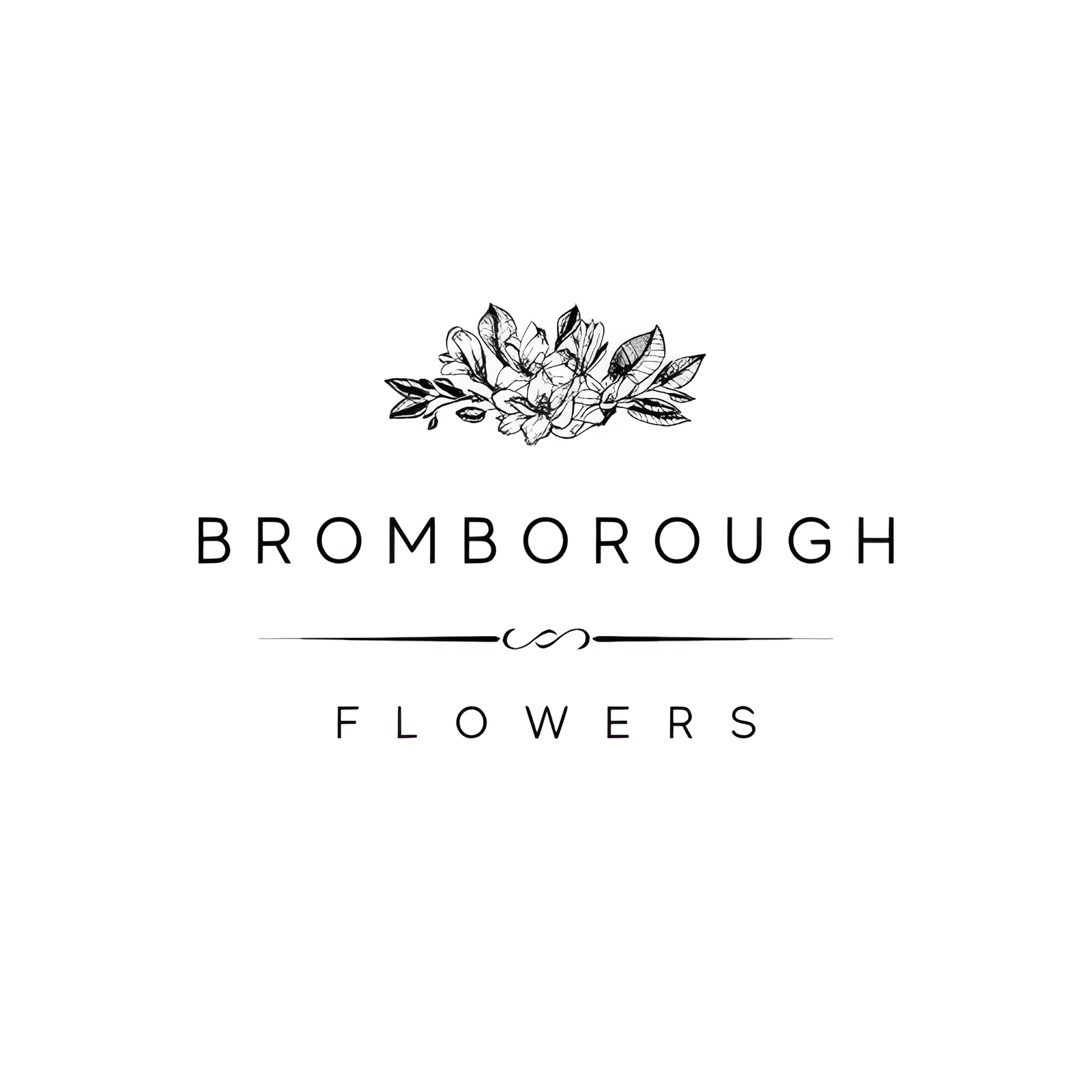Chrysanthemums, known for their striking hues and intricate petal formations, have long been favored in wedding decor for their affordability and profound symbolism of joy, fidelity, and longevity. Their versatility is unmatched, offering a spectrum of colors such as white, lavender, purple, yellow, and red to seamlessly complement various wedding themes. Whether incorporated into bridal bouquets, centerpieces, boutonnieres, corsages, or hairpieces, Chrysanthemums bring both elegance and a touch of tradition to wedding celebrations. What makes these flowers particularly intriguing is not just their aesthetic appeal, but their rich cultural significance and diverse forms, which invite a deeper exploration into their role in weddings.
Flower Overview

Chrysanthemums, known for their cost-effectiveness and worldwide popularity, offer a diverse range of colors and styles, making them a flexible choice for wedding decor. These flowers, acclaimed for their various symbolic meanings, can enhance any wedding theme with their assortment of hues and forms. Chrysanthemums symbolize fidelity, optimism, joy, and long life. The specific colors of chrysanthemums carry distinct symbolism: red signifies love, white represents truth, and yellow symbolizes unrequited love.
The wide selection of chrysanthemum varieties, including Cremon Mums, Cushion Pompon Mums, Football Mums, Pompon Button Mums, and Spider Mums, offers numerous options to fit different wedding aesthetics. Each variety features unique characteristics, amplifying their appeal for diverse wedding styles.
Chrysanthemums are available in a range of colors such as white, lavender, purple, yellow, green, bronze, red, and burgundy, guaranteeing they can complement any seasonal or theme-based decor effortlessly. Their cost-effectiveness makes chrysanthemums an appealing choice for budget-conscious couples without compromising on beauty or impact.
Whether used in bouquets, centerpieces, or other arrangements, their adaptability ensures that chrysanthemums can adjust to various wedding styles, providing both sophistication and allure.
Physical Description
With their vibrant array of colors and diverse forms, these flowering plants exhibit a remarkable range of physical characteristics that can be tailored to various wedding aesthetics. Chrysanthemums, often referred to as mums, possess a distinct charm that makes them an excellent choice for wedding arrangements. Their floral appeal is enhanced by their fresh, intricate petals, which can vary significantly in shape and size, adding texture and depth to any bouquet.
Chrysanthemums showcase timeless elegance through their vibrant colors and diverse forms. For instance, the Cremon Mums, resembling large daisies, provide a classic look with broad petals, while the Spider Mums offer a more contemporary twist with their thin, wide-stretching petals. These variations make chrysanthemums versatile additions to the perfect wedding bouquet, as they can complement numerous themes and styles.
Moreover, chrysanthemums are celebrated for their seasonal colors, particularly during autumn. They are available in hues such as bronze, red, and burgundy, which can add a rich, warm touch to wedding arrangements. The name ‘chrysanthemum’ itself means ‘golden flower‘ in Greek, reflecting their inherent vibrancy. Their physical attributes lend themselves to creating fresh and stunning displays that symbolize fidelity, optimism, joy, and long life.
Available Colour Varieties
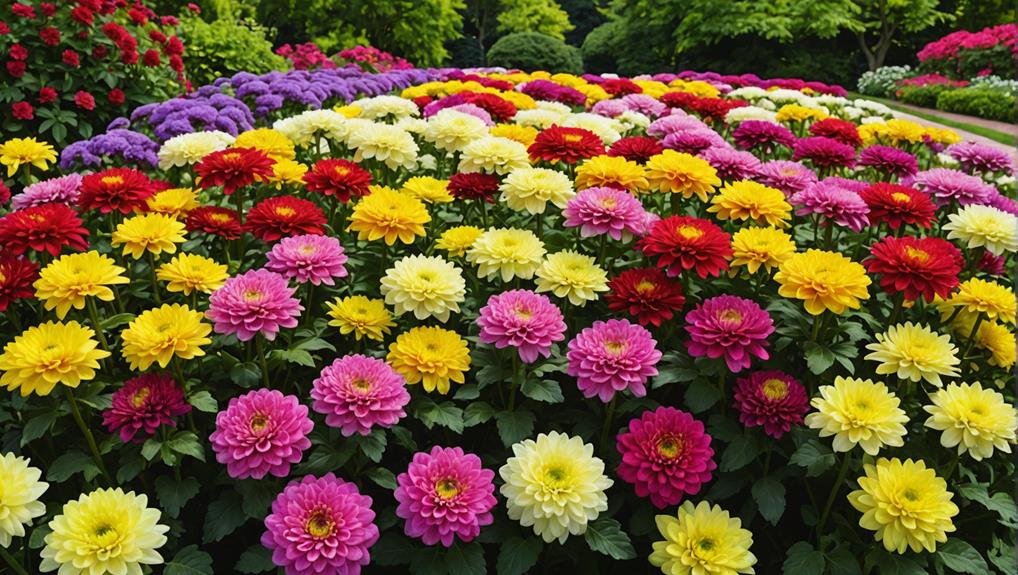
Given their extensive palette, chrysanthemums offer a multitude of color options that can seamlessly align with diverse wedding themes and aesthetic preferences. This versatile flower is available in both traditional and unique colors, making it an ideal choice for floral arrangements, bouquets, and centerpieces.
The seasonal availability of chrysanthemums, particularly in autumn, brings rich hues such as bronze, red, and burgundy, which are perfect for fall weddings. However, chrysanthemums are not limited to these tones. They also come in a wide range of colors including white, lavender, purple, yellow, green, and more. This diversity allows for creativity in matching the floral decor to any wedding theme, whether classic or contemporary.
Here is a quick reference table summarizing some of the diverse colors available:
| Traditional Colors | Unique Colors |
|---|---|
| White | Green |
| Yellow | Bronze |
| Red | Burgundy |
Chrysanthemums’ diverse colors make them a versatile choice that can adapt to various wedding themes. Whether you are aiming for a traditional look or something more unique, chrysanthemums offer a broad spectrum of color varieties to meet your needs. Their flexibility in floral arrangements, bouquets, and centerpieces assures that they can enhance any wedding’s aesthetic.
Latin Name and Taxonomy
In addition to their vibrant color varieties, chrysanthemums hold a fascinating position in botanical taxonomy as members of the Asteraceae family, scientifically recognized as Chrysanthemum. The name ‘Chrysanthemum’ is derived from the Greek words ‘chrysos’ meaning gold and ‘anthemon’ meaning flower, reflecting their historical significance and enduring appeal.
Chrysanthemums are herbaceous perennial plants, celebrated for their diverse and intricate petal formations. Within this genus, two notable species stand out: Chrysanthemum indicum and Chrysanthemum morifolium. Both species exhibit a wide array of forms and colors, making them popular choices for various floral arrangements, including wedding bouquets and centerpieces.
Key points about Chrysanthemum taxonomy:
- Family: Asteraceae, one of the largest families in the plant kingdom.
- Species: Over 40 wild species, including Chrysanthemum indicum and Chrysanthemum morifolium.
- Growth Habit: Herbaceous perennial plants, which means they live for more than two years and undergo seasonal growth and dormancy cycles.
- Petal Formations: Classified into several shapes such as Anemone, Quill, Spider, and Pompon, each offering unique visual appeal.
This botanical background underscores the versatility and rich heritage of chrysanthemums, further enhancing their desirability for elegant wedding floral designs.
Geographical Origins
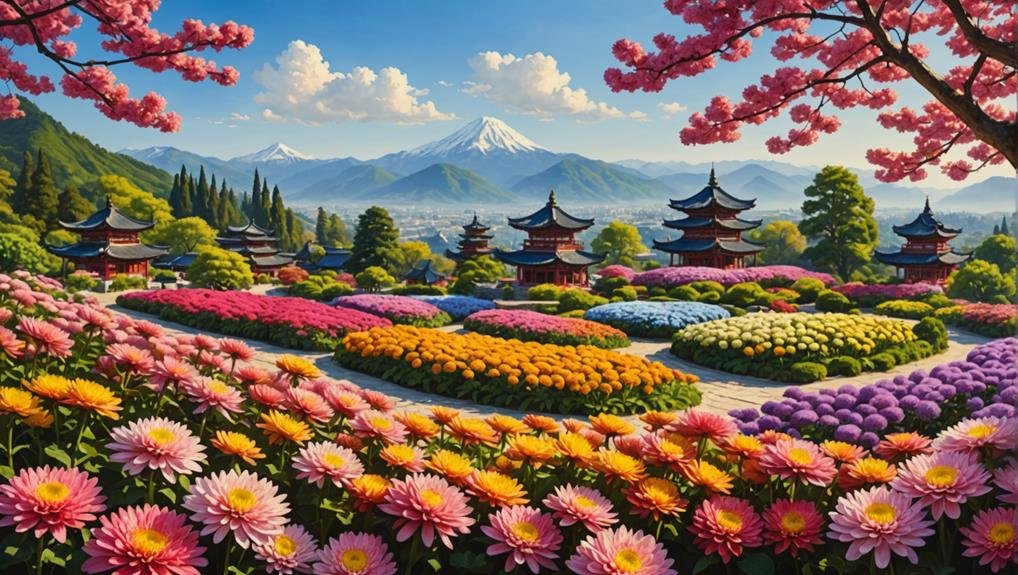
Chrysanthemums trace their origins to regions in Asia and northeastern Europe, where they have been cultivated and revered for centuries. These flowers have held significant cultural importance, particularly in China, where their cultivation dates back to the 15th century BC. By the 8th century AD, chrysanthemums had spread to Japan and were so cherished that they became the official seal of the Japanese Emperor, underscoring their esteemed status.
In both China and Japan, chrysanthemums have been symbols of abundance, wealth, prosperity, longevity, and eternal youth. Their cultural significance is deeply embedded in various traditions, ceremonies, and art forms, making them much more than mere decorative elements. The reverence for chrysanthemums in these regions speaks volumes about their impact on cultural heritage and societal values.
Beyond Asia, chrysanthemums have become beloved globally, admired for their diverse forms and vibrant colors. Their widespread acceptance and admiration underscore their universal appeal and symbolism.
Today, they are a popular choice for weddings and other special occasions, symbolizing joy and celebration. The rich history and profound symbolism of chrysanthemums contribute to their enduring popularity across different cultures and continents.
Season Availability
The lasting popularity of chrysanthemums is further boosted by their year-round availability, making them an ideal floral choice for weddings in any season. This versatile flower can seamlessly integrate into various wedding themes and color palettes, guaranteeing that your floral arrangements are both beautiful and seasonally appropriate.
Chrysanthemums exhibit a remarkable range of colors, which makes them adaptable to different wedding seasons. During autumn, these flowers are available in rich colors like bronze, red, and burgundy, perfectly complementing the warm tones of the season and enhancing the beauty of Thanksgiving weddings. In addition to their autumnal hues, chrysanthemums are also available in traditional wedding colors such as white, lavender, yellow, purple, and green, making them suitable for ceremonies throughout the year.
When planning your wedding, a florist consultation is essential to make sure you select the right chrysanthemum colors and varieties for your specific wedding season and theme.
Key considerations include:
- Year-round availability: Guarantees chrysanthemums can be used in any season.
- Autumn rich colors: Ideal for fall and Thanksgiving weddings.
- Traditional wedding colors: Versatile options for classic themes.
- Floral arrangements: Tailored to your wedding’s aesthetic and seasonal context.
This adaptability underscores the chrysanthemum’s lasting appeal in wedding floristry.
Growing Conditions
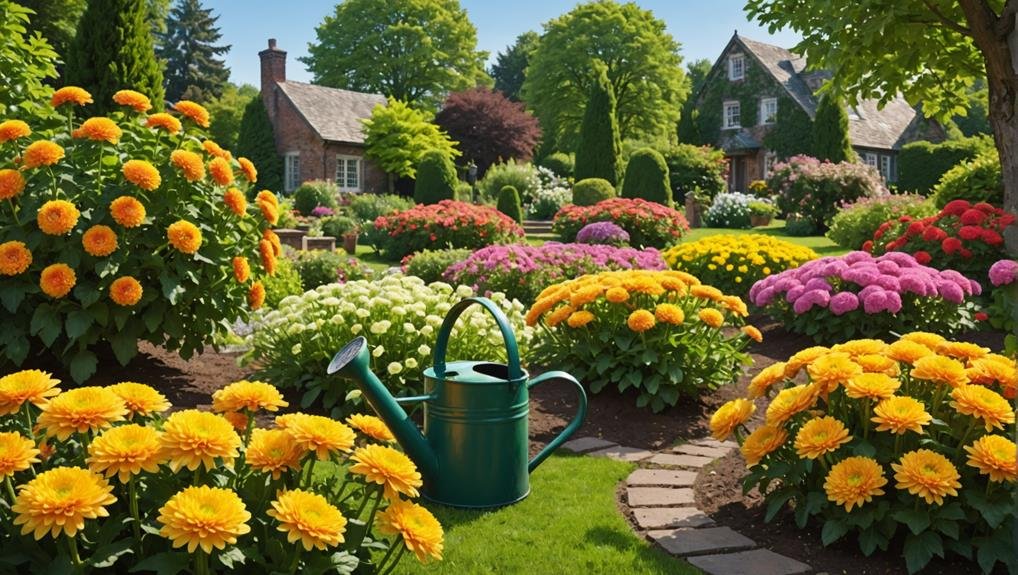
Ideal growing conditions are essential for ensuring chrysanthemums reach their full potential in terms of health and bloom quality. Chrysanthemums thrive best in full sun, requiring at least six hours of direct sunlight daily. The optimal growing medium is well-draining soil with a pH level between 6.0 and 7.0, ensuring the roots do not stay waterlogged, which can lead to root rot.
Regular watering is crucial; the soil should remain consistently moist but not saturated. Deadheading, the process of removing spent flowers, promotes continuous blooming and contributes to the overall health of the plant. Proper spacing between plants is also necessary to maintain good air circulation, which helps prevent diseases such as powdery mildew.
Mulching around the base of chrysanthemums can be highly beneficial. Mulch aids in retaining soil moisture, regulating soil temperature, and suppressing weed growth, all of which create a more stable environment for the plants to flourish.
| Key Aspect | Ideal Condition | Notes |
|---|---|---|
| Sunlight | Full sun | At least 6 hours of direct sunlight daily |
| Soil | Well-draining soil | pH level between 6.0 and 7.0 |
| Watering | Regular watering | Keep the soil consistently moist |
| Plant Care | Deadheading | Promotes continuous blooming and health |
| Spacing | Proper spacing | Ensures good air circulation |
| Mulching | Around the base | Retains moisture, regulates temperature, suppresses weeds |
Cultural Significance
Originating in Asia, chrysanthemums have played a significant role in various cultures for centuries. With their origins traced back to 15th century BC China, these flowers have been cherished for their beauty and intricate petals. Over time, chrysanthemums have become symbols of wealth, prosperity, and longevity, bestowing them with a high cultural significance.
By the 8th century AD, chrysanthemums had made their way to Japan, where they were adopted as the official seal of the Japanese Emperor, further solidifying their status as a symbol of eternal youth and prosperity. The vibrant colors and aesthetic appeal of chrysanthemums have ensured their continued popularity and reverence across different societies.
The cultural significance of chrysanthemums can be summarized through their various symbolic meanings:
- Wealth and Prosperity: Often seen as symbols of abundance and success.
- Longevity: Representing a long and healthy life.
- Beauty: Admired for their vibrant colors and intricate petals.
- Eternal Youth: Symbolizing timeless elegance and energy.
Chrysanthemums’ rich history and enduring symbolism make them not only a beloved flower but also a significant cultural icon in many parts of the world. Their intricate petals and vibrant hues continue to captivate admirers globally.
Typical Use in Weddings
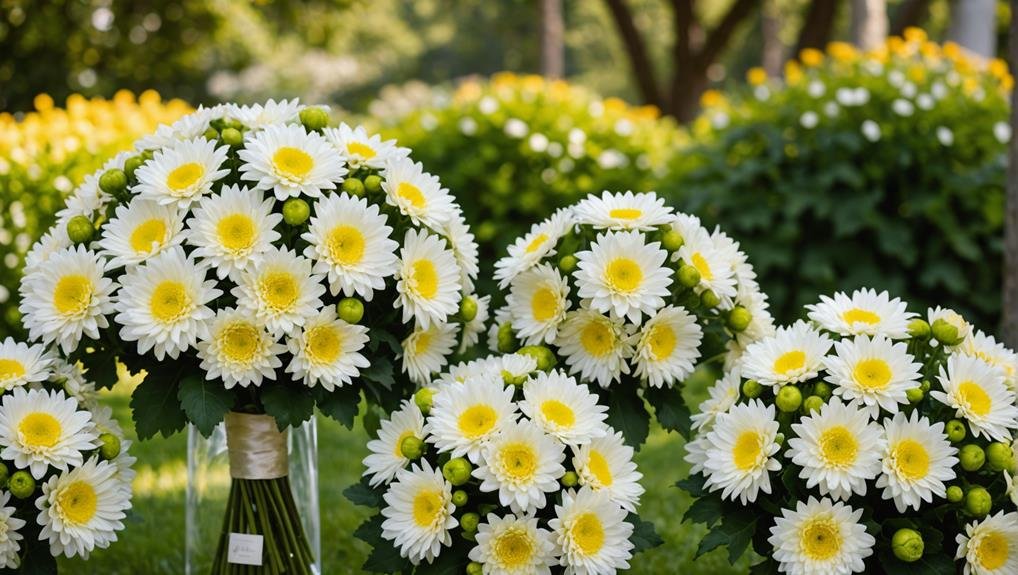
Chrysanthemums, with their rich symbolism and vibrant colors, are frequently chosen for bridal bouquets, centerpieces, and other wedding floral arrangements. These blooms, known for their versatility and affordability, are a staple in many weddings, enhancing the overall aesthetic and theme of the event. Chrysanthemums in weddings symbolize love, joy, longevity, and prosperity, aligning perfectly with the sentiments of a matrimonial celebration.
Bouquets
Chrysanthemums are often incorporated into bridal and bridesmaid bouquets, providing a splash of color and texture that complements various Floral Wedding Themes. Their diverse shapes and sizes allow for creativity in design, making them ideal for both traditional and contemporary Flower Arrangements. Additionally, chrysanthemums are popular choices for boutonnieres, corsages, and hairpieces, adding cohesive elements to the Wedding Decor.
In terms of Flower Care Tips, chrysanthemums are known for their longevity, ensuring that floral arrangements remain vibrant throughout the event. They are also utilized in wedding arches, aisle decorations, and reception settings, contributing to a harmonious and visually appealing Floral Decor.
Alternative Flower Types
When considering alternatives to chrysanthemums for wedding floral arrangements, roses, peonies, dahlias, lilies, and hydrangeas each offer distinctive attributes that can enhance the aesthetic of the event. Each of these alternative flower types brings its own unique colors, shapes, and textures to complement various wedding themes.
Roses are a timeless choice, symbolizing love and romance with their classic beauty. Available in a plethora of colors, they can effortlessly match any wedding palette.
Peonies, known for their lush, full blooms, represent prosperity and good fortune. Their soft, pastel hues bring an air of elegance and sophistication to the arrangements.
Dahlias stand out with their intricate petal arrangements, signifying elegance and adding depth to any floral display.
Lilies, with their striking shapes and vibrant colors, symbolize purity and bring a fresh, clean look to the decor.
Hydrangeas, versatile in their large, round clusters, represent gratitude and can be used to create voluminous, textured centerpieces.
- Roses: Symbolize love and romance, available in many colors.
- Peonies: Represent prosperity and good fortune, known for lush blooms.
- Dahlias: Signify elegance, with intricate petal arrangements.
- Lilies: Symbolize purity, offering striking shapes and vibrant colors.
Consulting with a florist can help in selecting the best alternative flower types to create stunning wedding floral arrangements.
